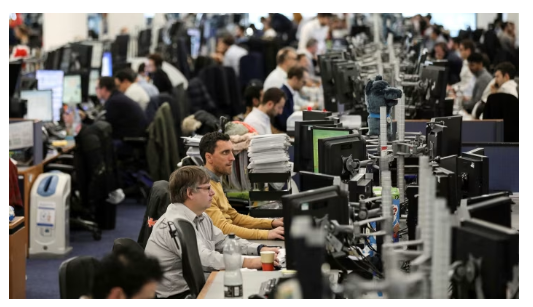Regulated spot and leveraged cryptocurrency trading in America is slowly but surely coming out of the shadows and into the mainstream. Over the last several weeks, top officials from U.S. regulatory agencies and major exchanges have taken certain steps that will enable leveraged spot trading on these platforms and in these marketscoming not just on the horizon, but now imminent. This is important for all concerned with cryptocurrency. (tradingview)

U.S. regulators and exchanges are paving the way for leveraged spot crypto trading. (Image Source: LiteFinance)
The CFTC is vigorously advancing, under the direction of acting chairwoman Caroline Pham, the objective that organised U.S. exchanges should have functional regulated spot and leveraged spot markets by this December, with engagement and readiness guidance on custody, margins, and surveillance in place.
Coinbase, among other market leaders, has already introduced US-compliant derivatives and perpetual futures contracts that closely reflect the spot market, demonstrating its readiness to extend products and operations to leverage spot contracts.
Major players in the market infrastructure, such as NASDAQ, Cboe, and large derivatives exchanges, are lining up to launch regulated cryptocurrency derivatives on their trading platforms, a development that will inject the current market with traditional market-making activities that have until now been relegated to a fragmented retail space.
Why This Is Not Just Another Press Release
Smaller regulatory shifts have seismic consequences if they unlock all three elements: legal clarity, custody mechanics, and institution-wide access. Today, all three levers are being pulled.
Regulators: A New Pace Of Business
The acting leadership on the CFTC is operating with a tight timeline and a clear goal: to bring a subset of crypto instruments under current commodities law and allow approved commodities exchanges to offer margin-like spot contracts for such instruments under strict supervision and safeguards for customers. It’s not a laissez-faire policy. Rather, it is a regulation. This changes the business model for exchanges and risk profiles for banks and market makers who have until now chosen to stay out of the retail margin business involving crypto.

CFTC leaders are pushing to regulate margin-style crypto spot trading under strict oversight (Image Source: AInvest)
Exchanges: From Derivatives To Leveraged Spot Ex
Not only is this not conceptual, but the development by Coinbase of U.S. regulator-compliant perpetual futures, and others’ plans for a diversified product offering, shows that these platforms have all it takes to integrate 2x–5x leveraged spot trading on top of their spot trading order books. If a compliant exchange uses pre-established custody and margin arrangements for providing 2x–5x spot leverage, it would simply be an extension.
Why Liquidity And Price Discovery Are Improved
If leveraged spot is made available on regulated exchanges, then the institutional market makers will be able to enhance the spreads. Thus, there will be improved price discovery, and the arbitrage opportunities between the U.S. retail markets and the offshore derivatives-trading platforms will decrease. What this means is that traders will have lower levels of market slippage and lower instances of shock effects on opening market prices. (ssa)
Real-World Stakes: Risk And Reward
Leverage amplifies upside and downside. Recent liquidation waves in November showed just how vulnerable even a derivatives market can prove when leverage interacts with volatility. The synchronized entrance by regulative entities would demonstrate how volumes can be amplified and be subjected to provisions of stricter risk management, like initially required margins, maintenance margins, auto-deleveraging terms, and kill switches, which would protect retail traders much better than is now the case in many offshore markets.
Banking And Fiat Rails: The Missing Piece That’s Finally Coming Together
Partnerships for traditional banking and settlement rails are necessary. If major banks and global payment systems meet or beat the bar for regulation, this will increase on-ramp and off-ramp options for American retail and institutional traders. Recent collaborations between banks and exchanges, with easier enforcement policies on other fronts, now allow liquidity providers and market makers to easily engage with exchanges without running afoul of traditional risk preferences. It is much easier to scale any new offering with functioning plumbing.
What Will Change In Product Design With Respect To Offshore Margin Platforms?
Expect three essential design variations on “regulated venues”:
- Facilitate transparent collateral accounting, with clearer separation between customer and margin.
- Capped Leverage Retail-friendly leverage ratios, such as 2x–5x, instead of the high multipliers used abroad.
- Improved surveillance and circuit breakers: exchange-level risk policies linked to regulator reporting.
- Such design features dampen headline-grabbing volatility while promoting overall long-term participation by conservative retail and institutional investors.
Trader’s Quick Checklist
If You Plan To Trade On Leveraged Spot
- Confirm the legal packaging and jurisdictional authority. Is it a CFTC-regulated product or exchange-regulated?
- Look at leverage limits and how margin calls work. Understand your risk exposure.
- Research liquidity: look into market depth and market makers.
- Understand your monitoring process: this is particularly crucial in case things do not turn out as expected.
Winners And Losers In Market Structures
- Winners: Regulated exchanges, institutional market makers, custody organizations, and fintechs that integrate bank rails with crypto networks.
- Losers Least Challenged: Offshore exchanges operating outside of regulation with opaque risk models and non-bank fiat rails. With liquidity beginning to shift into normalized tech stacks, this could lead to offshore exchanges having reduced access to a structured network providing market liquidity and arbitrage funds.
Storytelling Moment: What A Market-Maker Sees
Suppose a market-maker wakes up with a client order flow that includes both retail churn and institutional execution. In a regular market, such a market-maker can improve his quotes because regulatory certainty reduces his risk of sudden, unplanned exposure. The market-maker’s improved quotes attract more business. Volume grows in a self-reinforcing spiral. Volatility that previously offset liquidity now generates predictable profits for traders willing to mitigate risk. That is how more liquidity is created. The market will be resilient but only if risk strategists join product strategists in launching new business.
What Might Throw It All Off?
Political currents and legal risk are always lurking in the background. If enforcement shifts or a high-profile failure happens, regulators might pull in their horns and require product withdrawals. Also, if banks retract their participation in correspondent links, fiat settlement might bottle up. Finally, if exchanges don’t properly value risk provisioning for stress scenarios, forced unwinding might spread contagion.
Short Case Study: Road-Testing Operations On Coinbase
Its recent foray into U.S. perpetual-style futures derivatives provides a template for development for this space: first, develop compliant derivatives. Work out the kinks around surveillance and custody processes. Only then can one even think about offering related leveraged spot experiences. Such incremental development helps manage risk and validate business models. This is just what policymakers have been waiting for.
Regulatory Watchlist: What To Watch For This Month
- Formal CFTC guidance or interpretive letters on leveraged spot mechanics.
- Filing of exchange rules with self-regulatory organizations, if applicable.
- Banking and custody partnership announcements.
- Liquidity provider commitments or market-maker programs.
- Events of significant liquidation. Results of systemic stress tests.
CFTC SIGNALS LEVERAGED SPOT CRYPTO TRADING ON REGULATED EXCHANGES
The Acting CFTC Chair confirmed they are working with regulated U.S. exchanges to introduce leveraged spot crypto trading.
This would allow traders to use leverage directly on spot Bitcoin and crypto markets,… pic.twitter.com/DgIjcW8jZP
— CryptosRus (@CryptosR_Us) November 10, 2025
What Will Happen With Leveraged Spot (The Plumbing)
What is interesting about leveraged spot is that it’s simple to conceptualize: it is just a matter of borrowing against collateral to increase exposure to the asset underlying a position that one is holding in spot. But this consists of three interlocked systems: margin accounting, custody, and risk monitoring.
Margin Accounting
The margin accounting process for these regulated markets will reflect more conventional securities margining practices rather than ad-hoc approaches found on offshore hubs. Initial margins, maintenance levels, automatic margin calls, and last-liquidation levels will be organized to favor orderly unwinding. These will mitigate tail risks that exist for the retail market in such unregulated markets.
Custody
Custody will matter even more. Regulated exchanges will have institutional custody arrangements or bank custody wrappers, with segregated client funds, auditable proof of reserve, and clear recourse for disputes. Such segregation of client funds, together with house liquidity, makes all the difference: comingled asset shortages shall no longer be a concern, and institutional traders will feel confident enough to market tighter prices. One such case, where custody and regulation precede product development, is an exchange entry into CFTC-like derivatives.
Surveillance Links
All of these systems have surveillance links. All exchanges will report trade, match, and book information to automated surveillance systems capable of detecting wash trades, spoofing attempts, abusive squeezes, and concentration risk. Such systems will enable exchanges to rapidly control orders and notify regulators. This will minimize the risk of cascade breakdowns that used to cascade from retail-only exchanges to the overall market.
Scenarios Modelled: Three Possible Futures
Scenario A: Smoother Induction Or Onboarding Process (Most Constructive)
- Exchanges introduce leveraged spot with limited but conservative multiples (2x–5x), robust custody, and agreements with market makers.
- Liquidity increases and spreads narrow.
- Institutional trading comes back and arbitrage opportunities are reduced.
- Retail traders enjoy better execution.
- The market sees volume rise but reduced individual security volatility.
This is what regulators would like to see.
Scenario B: Volatility-Driven Growth (Short-Term)
- Launch sees heavy retail participation and speculation. Leverage magnifies both.
- Volume expansion is rapid, but periodic crashes provide sharp intraday moves.
- Exchanges rely on safety nets: circuit breakers, auto-deleveraging.
Effect: volumes increase on average, but stress situations test risk managers.
Scenario C: Fragmentation And Regulatory Backlash (Tail Risk)
- In case of mispricing of risk in one or more venues or significant liquidity events with huge contagion effects, there may be a hold on product growth by regulators.
- Banking partners might withdraw. Innovation and liquidity would be at a standstill during this time.
Risk Control Templates for Traders To Use
Position Sizing
- Be strict about position sizing.
- Risk no more than 1–2% on each leveraged trade; overall account leverage exposure should be capped at no more than 2x, for example.
Stop-Loss Orders Related To Volatility
- Use stop-loss orders related to volatility. Fixed pips on stop-loss orders can be risky, as one might, instead of closing out with actual pips, get stopped out on volatility.
Buffer Maintenance
- Keep some reserve funds or stablecoins on hand to manage sudden situations like margin calls.
Know Your Counterpart’s Regulations
- Read your exchange’s contingency and dispute-resolution agreements.
- Understand who has possession of the keys and jurisdiction.
Simulate Liquidation Events
- Perform a paper trade stress test with a 15–30% adverse market move against positions.
- Observe how margin calls and liquidations occur on the exchange.
Industry Structure Effects: Who Benefits, Who Adapts
- Institutional market makers have predictable models regarding order flow and hedging.
- Custody providers and banks will create revenues through the development of cost-of-compliance infrastructure.
- Those fintechs that can do position analytics/margin reporting will see new business for their product.
- Market pressure and outflow of liquidity for the non-regulated offshore platforms come due to counterparties moving to a managed stack. They will then have to adjust to managing these issues or targeting non-US markets.
Timeline To Watch: Concrete Milestones
Next 30 Days
- Rule filings with the exchange, or formal guidance/interpretive notes put out by the CFTC. These will inform you about operating parameters.
Next 60–90 Days
- Liquidity provider commitments and market-maker incentive programs. Search for letters of intent or programs offering bid-ask quotes during onboarding.
Quarterly
- Stress test results and experiences of early adopters, margin call and performance analyses would form part of the post-launch review.
Ongoing
- Bank/custody partnership agreements and any regulatory enforcement letters. That determines long-term viability.
Also Read: Bitcoin Reserve Build-Up 2025 Drives Corporate Adoption
Vignette: Institutional Trader’s Perspective
Imagine a prop trading desk that, up until now, has avoided U.S. retail markets due to murky counterpart risk. With appropriately managed leveraged spot trading, this desk can now net out hedges with on-exchange positions and cross-market hedges with futures traders. This reduces execution risk and pools both over-the-counter and exchange business. The desk will now firm up quotes somewhat because it will be capitalized for risk management purposes; market participants will notice improved market depth, and retail traders will see that when they hit ‘market’, they’re actually spending lower spreads.

Institutional trading: Regulated leveraged spot tightens spreads and deepens markets for retail. (Image Source: FT Alphaville – Financial Times)
What Industry Leaders Are Saying: Synthesised
- Regulatory signaling is important. The current acting leadership of the CFTC has been working with the exchanges to smooth out legal frictions and implementation issues, an important signal of serious commitment to opening regulated channels for leveraged spot commodities in the near term.
- Exchanges like NASDAQ and Cboe have been quickly working on their tech and filing rulemaking.
- Crypto-native companies such as Coinbase have actually done this work in advance by offering CFTC-regulation-compliant derivatives and other advanced custody solutions.
Red Flags To Watch For
- Breakups of partnerships in banks or enforcements against a big market could bring things to a standstill.
- Unrealistic high leverage marketing, sometimes as high as 100x, in the headlines by smaller operators can be indicative of impending regulation.
- Counterparty risk can amplify the effect of risk concentration on a market-maker or custodian.
Actionable Checklist For Stakeholders
- Retail Traders: Know your margin terms, take conservative position sizing, and use volatility stops.
- Institutional Trading Turrets: Negotiate market-maker discounts, custodian proof testing, and negative hedging exercisers.
- Exchanges: Develop and publish contingency plans, establish default waterfall funds, and go through public stress testing.
- Regulators: Balance accessibility with prudent safeguards; this is a gradual process.
Closing Thought
The emergence of leveraged spot trading on U.S. exchanges is a significant upgrade to market infrastructure. Retail participation will now be conducted with rigor that comes with traditional regulation on U.S. exchanges, which will improve market efficiency.
That will not diminish risk. Leverage is a multiplier for everything: good and bad outcomes. What it does bring is a market that begins to feel much more like what traders know: clearly defined regulations, lots of liquidity, and functional resilience. Trader, institution, and regulator alike, these coming months will prove to be even more critical than when spot ETFs first landed. Look to the disclosure documents, read up on margin policies, and don’t underestimate the leverage power tool.
Frequently Asked Questions
- Q: Is leveraged spot the same thing as futures?
A: No. One is a leveraged fund amplifying a spot exposure, and futures are derivatives. While both can give the same economic exposure, custody and regulatory treatment will differ. - Q: Will exchanges allow 100x leverage?
A: Likely on restricted U.S. exchanges; conservative ceilings, 2x–5x, can be expected due to risk aversion for teams and regulators favoring protection for retail market participants. - Q: Could this impact crypto price discovery for better or worse?
A: Both. Liquidity enhances spreads and reduces slippage. Still, it amplifies volatility risks, while synchronized selling could heighten declines. - Q: Retail traders: should they rush in?
A: Only when you have understood margin mechanics and only with strict risk management. Leverage can increase losses exactly as it increases gains. - Q: Is regulation now friendly toward crypto?
A: The reality is that the tone now coming out of many agencies is much more pragmatic and interested; this by no means implies a free pass. - Q: Will I have ownership in the underlying asset with a leveraged spot?
A: Yes, you’ll be using leveraged spot when you’re holding a spot position and you’ve borrowed funds using collateral. That’s different for futures because with futures, you hold a contract that follows the underlying. - Q: Is it safer to buy leveraged spot than perpetual futures?
A: “Safer” is relative. Regulated leveraged spot involves custody segregation, improved margining, and surveillance. Perpetuals have uses for hedges. They both involve leverage risk. - Q: What is the process followed by exchanges to determine leverage caps?
A: Exchanges and regulators consider the level of volatility, market liquidity of the asset, and how much consumers need to be protected. Be prepared for conservative multiples to start with, usually much lower than 100x marketed on international exchanges. - Q: Will taxes or reporting change?
A: Is this likely? Indeed, regulated establishments will need to produce clearer reporting on trade and taxes. For traders, expect improved reporting on 1099s in the US, or equivalents in other regions. - Q: Could leveraged spot facilitate new ETFs or ETPs?
A: Yes. Improved on-exchange liquidity and custody arrangements facilitate the design of ETPs by issuers who depend on deep and well-regulated spot markets. That’s a supply-related effect that complements market demand.

